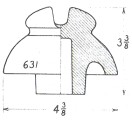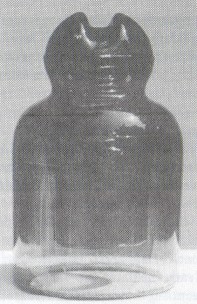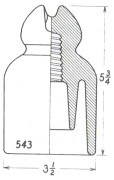Foreign Insulators
by Marilyn Albers
Reprinted from "Crown Jewels of the Wire", August 1995, page 29
WHAT A FIND! OR IS IT?
You are looking at what appears to be a CD 631, a rather plain glass
insulator known as the “Unembossed Bright’s Patent”, which dates from the
early 1860’s. Some of you will recognize this threadless style from a similar
photo and drawing in Glass Insulators from Outside North America, Second
Revision or you may remember having seen it in W. Keith Neal’s book Searching
for Railway Telegraph Insulators. CD 631 was patented by Mr. C. T. Bright of
England and it is extremely rare with only two examples known to have survived,
one in the British Telecom Museum of London and the other in the late Mr. Neal’s
collection in Guernsey, Channel Islands. During a 1989 visit to Keith’s home,
the CD 631 was one of many that I was privileged to hold in my hand, photograph
and measure by shadow profile. I remember the olive green color of the CD 631,
the metal pin on which it was mounted, and the many nibbles on the base rim of
the skirt and extended petticoat, which gave testimony to its many years in
service on the telegraph line. It seemed like a ghost out of the past. Needless
to say, many collectors of foreign glass would be happy to find one of these!
Mr. Neal’s entire collection has now been taken over by his daughter.



It just so happens that I have recently acquired a third specimen of CD 631
and the photos you see were taken in my back yard a few days before this article
was written. The glass color is dark emerald green and the piece is in
absolutely flawless condition. Indeed a beautiful piece of glass! But should you
feel a twinge of envy, read on. I am not the happy camper you would expect me to
be upon acquiring such a jewel. I write about this insulator not because I am so
fortunate to have it but because it is not authentic and I want you to be aware
of this should more of them find their way into the market. This insulator is a
1995 Reproduction! I am concerned about the growing number of fakes, unmarked
reproductions and color altered insulators that are infiltrating our hobby. So
where did this CD 631 repro come from? What’s the scoop?
A collector friend of mine in England, who for many years has scoured the
country looking for an authentic CD 631 without success (knowing full well he
will probably never find one), came up with what he thought was a perfect
solution. Using his engineering skills, he made a perfect scale drawing of the
piece and submitted it to a mold maker. The mold cost him the equivalent of
$2,000 U.S. Next he found a local glass factory that was willing to produce a
few of the insulators, though this sort of thing was not part of their normal
production line. My friend thought they would be more attractive in dark emerald
green rather than the dull olive green of the authentic CD 631! He had told me
in advance of his plans to produce them but I warned him that they should be
permanently marked in some way so they would not be mistaken for the real thing.
He listened politely, but he didn’t seem to feel it was all that important and
besides, the mold had already been made and he wasn’t too keen about changing
it. The next thing I knew he had 400 of these beautiful insulators in his garage
- and not a one was marked in any way. He really didn’t need that many, but I
imagine the glass company set that as a minimum before they would agree to do it
at all. What really makes me feel bad is that I’ve known him for years and he
is a good person. He is not an NIA member nor does he subscribe to Crown Jewels
of the Wire magazine, but he’s a dedicated insulator collector, he’s highly
intelligent and holds a responsible job. I am confident that he would not
willfully do anything to hurt anyone. But since he is “out of the loop”, he
sees no harm in what he has done and doesn’t understand our concern. Several
times in the past I have sold porcelain insulators for him, made by Allied
Insulators in Stoke-on-Trent, England. No problem. Then in June of this year he
sent me a sample of the CD 631 repro and rightfully assumed that I would market
them as I had done previously. However, this is a completely different situation
and I had to refuse. He is miffed and he is hurt. He asks “Is something better
than nothing or nothing better than something?” In this case the answer is
obvious. I hated to let him down, but I would be letting down a whole lot of
other folks in the hobby if I were to turn loose a bunch of unmarked replicas of
such a rare insulator, no matter how beautiful they are or how reasonable the
price might be. Even so, a few may eventually make their way across the ocean
through someone who is unaware that they are reproductions.
With only a few insulator collectors in England, the hobby is not really
organized there. Individuals communicate but there is no local market for
British insulators, thus no insulator shows. While it cost him a lot of money to
have the repros made, he says he is not trying to make big money nor is he
running some clandestine operation by passing off reproduction insulators as
original pieces. He feels that because they have been documented in his own
paperwork and in the production records of the factory, it is adequate proof of
their origin. But he is there and we are here and that offers little protection
for our collectors, even if they were to be given verbal or written information
at the time of purchase. Words aren’t always remembered, paper has a way of
disappearing, and I have yet to be impressed with records of insulator
production, if any, kept by European insulator manufacturers! What is there to
protect the next generation owner of the insulator? Engraving “1995 Repro”
on the base rim would help, but even that can be buffed off. We may not be able
to stop this sort of thing from being made, but we can at least educate our
collectors and try to keep these pieces away from our shows. Before writing this
article, I talked with Mike Guthrie, author of Fake, Altered and Repaired
Insulators and Dwayne Anthony, who has done extensive testing with the different
types of radiation sometimes used to enhance and/or change the original colors
of glass insulators. They both agreed that collectors should be made aware of
the situation. We are all indebted to Mike and Dwayne for helping us avoid some
of the potholes along the road to good collecting. If you attended the NIA
National in Marlborough, Massachusetts July 14-16, perhaps you were able to see
the CD 631 Repro at my table or at the NIA Friday night business meeting.
Readers, please feel free to send your comments, pro or con.
INSULATORS FROM MOROCCO
In April of this year my brother-in-law, Morris Albers and his wife Vivian
took a two week tour through Morocco. It was part of a continuing education
program called “Studies on Tour”, sponsored by the University of Texas at
Austin. I remember seeing many French and Spanish insulators on the lines when I
was there back in 1977, so I asked them to bring me any they could find.
(Morocco, independent since 1956, includes within its borders the former
protectorates of French Morocco and Spanish Morocco.) We met their plane in
Houston at the end of the trip and they were full of stories, including how
their tour guide had managed to find four insulators for them. Two were of
glass, one was a white porcelain rack spool, and the other a tiny black
composition insulator. I was delighted! The two glass pieces are the most
interesting and are shown below. The tall one is an unembossed CD 543 in rich
yellow green. The crown is a bit wider than those I’ve seen before, and while
it’s not enough to warrant a new CD number, it’s definitely a keeper. The
tour guide found this piece for Morris and Vivian in the city of Marrakesh. It
is of French origin and was designed for use on a power line. A bit of cement
remains in the pin hole, indicating that the insulator was mounted on a metal
pin.


The other glass insulator was a real surprise to me. It’s a clear CD155
WHITALL TATUM No. 1 made in the U.S.A. This was retrieved in the city of
Ouarzazate (pronounced War-za-zaht) and it also has traces of cement in the pin
hole, plus quite a bit of reddish (desert?) sand between the petticoat and
skirt. But what in the world was this insulator doing in Morocco? N.R. “Woody”
Woodward had a possible answer. The embossing on the rear skirt indicates that
the piece was of 1943 production, right at the time of World War II. Morocco was
part of the African theater, so it is likely that these insulators were brought
over by the U.S. Army Signal Corp for use on their military lines. When the war
ended, the insulators would no longer have been needed and were left behind. A
utility company in the area probably confiscated them for local use by cementing
them onto metal pins. Of course we have no proof of this, but it makes a good
story and it makes sense! The white porcelain rack spool and the black
composition insulator (not shown) also came from Ouarzazate. Neither is marked,
but we were told the little black one was used on a telephone line. Many thanks
to Morris and Vivian for bringing the insulators back and to Woody for his
helpful comments regarding the CD 155.
|
